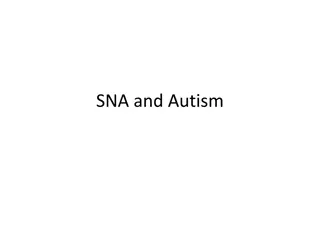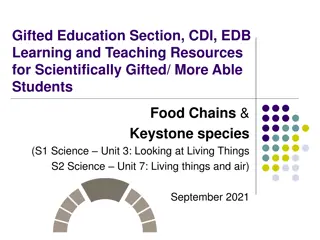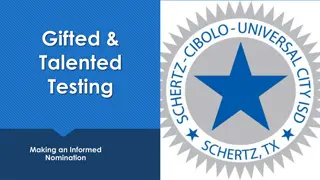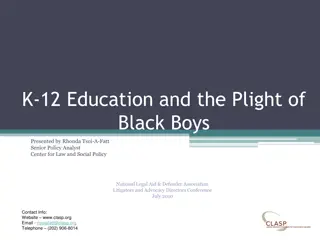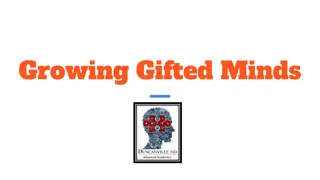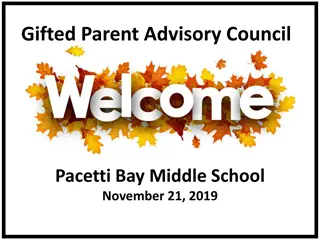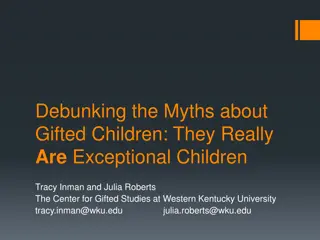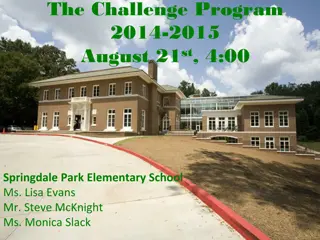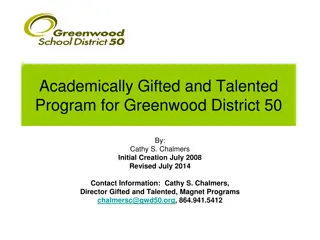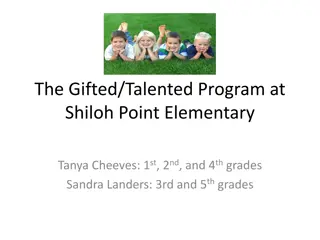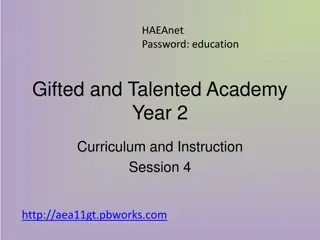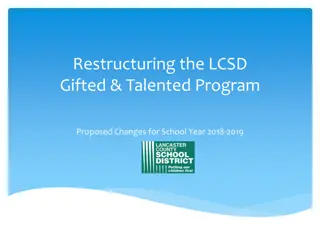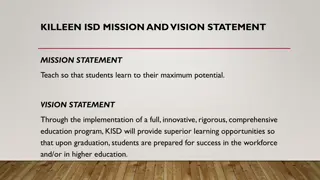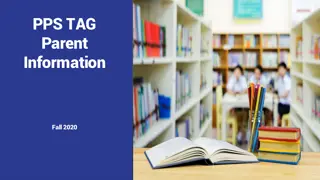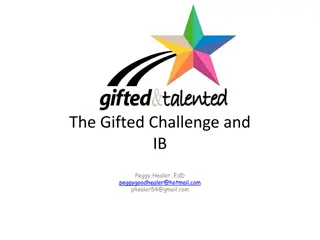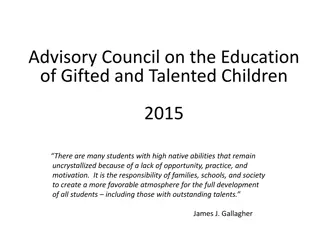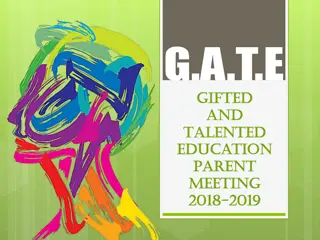Gifted Children: Characteristics & Needs
Gifted and talented children exhibit remarkable cognitive and affective traits that require special educational programs and personalized attention for optimal development. They possess advanced abilities in areas like intellectual, creative, artistic, and leadership capacities, needing differentiated services to reach their full potential.
Download Presentation

Please find below an Image/Link to download the presentation.
The content on the website is provided AS IS for your information and personal use only. It may not be sold, licensed, or shared on other websites without obtaining consent from the author.If you encounter any issues during the download, it is possible that the publisher has removed the file from their server.
You are allowed to download the files provided on this website for personal or commercial use, subject to the condition that they are used lawfully. All files are the property of their respective owners.
The content on the website is provided AS IS for your information and personal use only. It may not be sold, licensed, or shared on other websites without obtaining consent from the author.
E N D
Presentation Transcript
What is Gifted? 0 Gifted and talented children are those identified by professionally qualified persons who by virtue of outstanding abilities are capable of high performance. These are children who require differentiated educational programs and/or services beyond those normally provided by the regular school program in order to realize their contribution to self and society. (U. S. Commissioner of Education Sidney P. Marland, Jr.) 0 The term gifted and talented , when used with respect to students, children, or youth, means students, children, or youth who give evidence of high achievement capability in areas such as intellectual, creative, artistic, or leadership capacity, or in specific academic fields, and who need services or activities not ordinarily provided by the school in order to fully develop those capabilities. (No Child Left Behind, Title IX, Part A, Section 9101(22), p. 544)
Characteristics of Gifted Learners 0 Cognitive Characteristics 0 Process and retain large amounts of information 0 Comprehend materials at advanced levels 0 Curious and have varied and sometimes intense interests 0 High levels of language development and verbal ability 0 Possess accelerated and flexible thought processes 0 Early ability to delay closure of projects 0 See unusual relationships among disciplines or objects 0 Adept at generating original ideas and solutions to problems
Characteristics of Gifted Learners 0 Cognitive Characteristics 0 Persistent, goal-oriented, and intense on topics of interest 0 Form their own ways of thinking about problems and ideas 0 Learn things at an earlier age than peers 0 Need for freedom and individuality in learning situations 0 High desire to learn and seek out their own interests 0 Abstract thinkers at an earlier age than peers
Characteristics of Gifted Learners 0 Cognitive Characteristics 0 Prefer complex and challenging work 0 Transfer knowledge and apply it to new situations 0 May prefer to work alone 0 May be early readers 0 May possess high energy levels and longer attention spans
Characteristics of Gifted Learners 0 Affective Characteristics 0 Possess large amounts of information about emotions 0 May possess an unusual sensitivity to the feelings of others 0 Possess a keen or subtle sense of humor 0 Possess a heightened sense of self-awareness 0 Idealism and sense of justice appear at an early age
Characteristics of Gifted Learners 0 Affective Characteristics 0 Develop inner controls early 0 Possess unusual emotional depth and intensity 0 Exhibit high expectations of self and others 0 Display a strong need for consistency in themselves and others 0 Possess advanced levels of moral judgment
Characteristics of Twice Exceptional Students 0 Characteristics atypical of gifted students and atypical of students with learning disabilities 0 Outstanding ability in verbal and/or visual-spatial areas 0 Creative 0 Good problem solvers and critical thinkers 0 Strong commitment to tasks in areas of interest 0 Production difficulties 0 Written output 0 Organization 0 Memory
Characteristics of Twice Exceptional Students 0 Reading/decoding difficulties 0 Academic achievement not commensurate with ability 0 Struggle to learn basic skills due to processing difficulties 0 Strong observation skills but memory difficulties 0 Unwilling to take risks academically, but may take risks in non- school areas without consideration of consequences
Characteristics of Twice Exceptional Students 0 Sometimes appear immature (use anger, crying, withdrawal, etc. to deal with difficulties) 0 Require frequent teacher support and feedback in deficit areas; highly independent in other areas 0 Sensitive regarding disability area(s); highly critical of self and others, including teachers 0 Exhibit leadership ability; often leader among the more nontraditional students; demonstrate strong streetwise behavior; the disability may interfere with ability to exercise leadership skills
Challenges 0 Dropout 0 25% of gifted students are underachievers (http://www.davidsongifted.org/Search- Database/entry/A10398) 0 Teachers and parents may create perfectionism / underachievement 0 Early praise for being smart, rather than for effort 0 When things eventually get challenging, kids think they can t do it because they aren t smart enough!
Myths and Misconceptions 0 Myth: Gifted Students Don t Need Help; They ll Do Fine On Their Own 0 Truth: Would you send a star athlete to train for the Olympics without a coach? Gifted students need guidance from well-trained teachers who challenge and support them in order to fully develop their abilities. Many gifted students may be so far ahead of their same- age peers that they know more than half of the grade- level curriculum before the school year begins. Their resulting boredom and frustration can lead to low achievement, despondency, or unhealthy work habits. The role of the teacher is crucial for spotting and nurturing talents in school.
Myths and Misconceptions 0 Myth: Teachers Challenge All The Students, So Gifted Kids Will Be Fine In The Regular Classroom 0 Truth: Although teachers try to challenge all students they are frequently unfamiliar with the needs of gifted children and do not know how to best serve them in the classroom. A national study conducted by the Fordham Institute found that 58% of teachers have received no professional development focused on teaching academically advanced students in the past few years and 73% of teachers agreed that Too often, the brightest students are bored and under-challenged in school we re not giving them a sufficient chance to thrive. This report confirms what many families have known: not all teachers are able to recognize and support gifted learners.
Myths and Misconceptions 0 Myth: Gifted Students Make Everyone Else In The Class Smarter By Providing A Role Model Or A Challenge 0 Truth: Average or below-average students do not look to the gifted students in the class as role models. Watching or relying on someone who is expected to succeed does little to increase a struggling student s sense of self-confidence. Similarly, gifted students benefit from classroom interactions with peers at similar performance levels and become bored, frustrated, and unmotivated when placed in classrooms with low or average-ability students.
Myths and Misconceptions 0 Myth: All Children Are Gifted 0 Truth: All children have strengths and positive attributes, but not all children are gifted in the educational sense of the word. The label gifted in a school setting means that when compared to others his or her age or grade, a child has an advanced capacity to learn and apply what is learned in one or more subject areas, or in the performing or fine arts. This advanced capacity requires modifications to the regular curriculum to ensure these children are challenged and learn new material. Gifted does not connote good or better; it is a term that allows students to be identified for services that meet their unique learning needs.
Myths and Misconceptions 0 Myth: Acceleration Placement Options Are Socially Harmful For Gifted Students 0 Truth: Academically gifted students often feel bored or out of place with their age peers and naturally gravitate towards older students who are more similar as intellectual peers. Studies have shown that many students are happier with older students who share their interest than they are with children the same age.3 Therefore, acceleration placement options such as early entrance to Kindergarten, grade skipping, or early exit should be considered for these students.
Different Types of Gifted Learners Prodigies Demonstrated High Performance Creative Producers Above-grade Achievers Supports (Self, Family, School) Inhibitors (Self, Family, School) Gifted Learners Twice Exceptional Low SES Underdeveloped Performance Culturally/Linguistically Diverse Underachievers *Taken from Gifted Program Evaluation by Kristi Speirs Neumeister and Viriginia H. Burney
The Identification Process 0 Align identification procedures to program service areas 0 What programs are being offered? Academic only? Creativity and leadership? 0 Make sure identification procedures and assessments are appropriate for that area(s)
The Identification Process 0 Multifaceted Assessment Protocol 0 Include measures of actual performance as well as those with performance POTENTIAL 0 Measures of Achievement/Performance 0 Norm-referenced achievement tests with NO ceiling 0 Grade level tests are difficult in identification because there is nothing to distinguish between on-level performers/good students and those who need advanced curriculum 0 Measures of Ability/Potential 0 Find other students who may not be achieving but have the ability to be a high performing student 0 Qualitative Measures 0 Teacher checklists, portfolios, observations, interviews 0 Helpful when quantitative data is not definitive 0 Not necessary to show high scores in ALL of these facets
The Identification Process 0 Sample Processes 0 TX school 0 Teacher and parent referrals based on performance and/or observations given either CogAT or KBIT Ability test 0 Students scoring in 95th percentile or above on norm- referenced achievement test given either CogAT or KBIT Ability test 0 MI school 0 Students scoring in 95th percentile or above on IOWA in reading comprehension and/or math 0 Teacher and parent referrals 0 SAGES-2 administered to help identify area of giftedness
Identification Tools 0 Cognitive Abilities Test (CogAT)- Assesses verbal ability, nonverbal ability and quantitative ability 0 http://www.hmhco.com/hmh-assessments/ability/cogat-7 0 Kaufman Brief Intelligence Test (KBIT)- Assesses verbal and nonverbal ability and provides IQ composite 0 http://www.pearsonclinical.com/psychology/products/100000390/kaufman-brief- intelligence-test-second-edition-kbit-2.html 0 SAGES-2- Individual or group administration, assess aptitude and achievement 0 http://www.prufrock.com/SAGES-2-Complete-Kit-Screening-Assessment-for-Gifted- Elementary-and-Middle-School-Students-P104.aspx 0 SIGS- Home and school rating scales addressing 7 areas: (1) general intellectual ability; (2) language arts; (3) mathematics; (4) science; (5) social studies; (6) creativity; and (7) leadership 0 http://www.prufrock.com/SIGS-Complete-Kit-Scales-for-Identifying-Gifted-Students- P123.aspx
Identification of Twice Exceptional Students 0 Identified Gifted Students (Learning Disability not identified) 0 First noticed for achievement and/or high IQ 0 Already identified or in program for gifted students 0 Discrepancy between expected and actual performance 0 High level of achievement difficult to maintain 0 Longer writing assignments 0 Heavier reading material 0 More organization and study skills required
Identification of Twice Exceptional Students 0 Students may become depressed, discouraged and doubt ability 0 May be overlooked for learning disabilities 0 May be able to perform at an average level even though ability much higher 0 C students don t often get referred for learning disabilities evaluation 0 Gifted students not achieving to potential not necessarily a learning disability 0 Giftedness may only be in certain areas, not all academic areas 0 Curriculum may seem unchallenging or uninteresting 0 Rule out other explanations
Identification of Twice Exceptional Students 0 Students identified with Learning Disabilities (Giftedness not identified) 0 First noticed for learning disabilities (more severe, may be few grades levels behind) 0 Approximately one third of identified individuals with learning disabilities have superior intellectual ability (above 120) 0 Often, schools will work on the disability and what the student can NOT do before attending to or noticing the giftedness 0 Focus on the disability leads to feelings of inadequacy and overshadows positive feelings from areas of strengths
Identification of Twice Exceptional Students 0 Students not identified for giftedness or learning disabilities 0 Giftedness masks the disability and disability masks the giftedness 0 Giftedness may allow students to compensate enough to perform at grade level 0 Learning disability prevents the giftedness from being noticed
Identification of Twice Exceptional Students 0 Gift or talent may come through in environments that require less written work, more projects and discussion 0 By the time learning disability and/or giftedness is discovered, student may already be discouraged about school and learning because their talents are not emphasized in some traditional classrooms 0 May be seen as reluctant learners
Classroom Strategies 0 Good teaching for gifted learners requires an understanding of "supported risk." Highly able learners often make very good grades with relative ease for a long time in school. They see themselves (and often rightly so) as expected to make "A s," get right answers, and lead the way. In other words, they succeed without "normal" encounters with failure. Then, when a teacher presents a high-challenge task, the student feels threatened. Not only has he or she likely not learned to study hard, take risks and strive, but the student's image is threatened as well. A good teacher of gifted students understands that dynamic, and thus invites, cajoles and insists on risk-but in a way that supports success.
Classroom Strategies 0 Differentiate Content 0 Provide more challenging reading materials 0 Focus on the overall trends, patterns and themes rather than small details and facts 0 Study problems that do not have a clear solution 0 Use topics of interest to the student, relevant to how the world works, complex and worthwhile
Classroom Strategies 0 Differentiate Process 0 Allow for flexible groupings of students: individual, pairs, small groups 0 Create specialized learning centers for skill work 0 Encourage creativity and reward risk-taking 0 Provide opportunities for divergent (many answers) and convergent (best answer) thinking 0 Explicitly teach skills needed to learn independently (research, organization, etc.)
Classroom Strategies 0 Differentiate Product 0 Allow a variety of acceptable products (using Multiple Intelligences, for example) 0 Offer leveled projects (For an A..., For a B..., etc.) 0 Involve the student in creating the scoring guide 0 Assign tasks that are authentic and for a real audience 0 Match the product to the outcomes being met
Classroom Strategies 0 Presentation Strategies: 0 Vary the method of presentation: lecture, small groups, large group, demonstration, individual experimentation 0 Avoid having student copy notes when material is already mastered 0 Curriculum Strategies: 0 Provide opportunities for open-ended, self-directed activities 0 Provide instruction in research skills needed to conduct an independent study in student s interest area 0 Provide independent learning opportunities 0 Use advanced supplementary/reading materials 0 Encourage the use of creativity Ask higher level questions 0 Provide opportunities to develop depth and breadth of knowledge in a subject area
Classroom Strategies 0 Organizational/Behavior Strategies: 0 Use a Study Contract for student to achieve outcomes 0 Use a Learning Log for independent or outside learning 0 Establish a timeline for long-range projects 0 Motivational Strategies: 0 Provide fewer drill and practice activities when material is learned 0 Give student choices of activities in learning the content 0 Allow the student to buy time for self-directed activities after material is learned
Classroom Strategies 0 Assessment Strategies: 0 Give a pretest to allow the student to demonstrate mastery 0 Provide self-checking materials 0 Provide tests at a higher level of thinking 0 Environmental Strategies: 0 Arrange for a mentor to work with the student in interest area 0 Cluster group gifted/talented students by areas of strength in the classroom 0 Allow independent use of library
Classroom Strategies: Curriculum Compacting 0 Involves eliminating the repetition of work that has already been mastered and streamlining lessons that can be mastered at a pace commensurate with the student's motivation and ability 0 Define goals and outcomes of a lesson 0 Identify if certain students have already mastered certain goals and outcomes of the lesson 0 Provide acceleration and enrichment options instead of repetition of goals already mastered
Classroom Strategies: Providing Choices 0 Menu with weighted choices 0 Alternative reading assignments 0 Project choices 0 Rubrics Choices are highly effective for gifted learners. Options should include complexity, creativity, and depth.
Classroom Strategies: Orbital Studies When students demonstrate they grasp key skills and concepts within a unit of study-- 0 Orbitals are short term independent investigations 0 Explore aspect of unit in greater depth 0 Replace class participation and assignments for unit
Classroom Strategies 0 First Five 0 Give students the 5 most difficult problems on an assignment first 0 If they correctly complete these, provide an alternative extension activity rather than completing same assignment 0 Take It Up 0 For different units/lessons, have folders or tray of alternative work to take it up or take it down
Classroom Strategies 0 Independent Study 0 Student and teacher work out parameters for process (how much time each day, where research will take place, what materials will be needed, what other persons will be involved, etc) and product (how will the student demonstrate what was learned, will the product be shared, will it serve a real life purpose, etc.) 0 Good option for students who finish work quickly and accurately
Classroom Strategies 0 Study Contract 0 The study contract is used when the student has already met some but not all outcomes for a particular unit. A menu of mutually-acceptable choices should accompany the study contract to ensure the student is using time wisely. 0 Keeps students working alongside peers in same area but allowing for choices with content already mastered
Classroom Strategies 0 Learning Log 0 To detail outside hobbies and experiences arranged through their parents or mentors. This learning can be compatible with the classroom curriculum. 0 The teacher may allow the student to complete a learning log of her experiences to show what she has learned and how it connects to classroom outcomes. This may free up time for the student to pursue other interests during the school day or provide evidence of learning for her to move on to the next unit or level in a particular subject. A learning log is also a good assessment tool for a mentorship.
Educational Materials 0 Destination Imagination: https://www.destinationimagination.org 0 William & Mary Center for Gifted Education: http://education.wm.edu/centers/cfge/curriculum/mater ials/index.php 0 IN High Ability Units: http://form.jotform.co/form/32165696183865 to sign up 0 Junior Great Books: http://www.greatbooks.org 0 Gifted Learning Links (online programs from Northwestern University): https://www.ctd.northwestern.edu/program_type/online- programs
Inappropriate Education for Gifted Learners 0 Asks them to do things they already know how to do, and then to wait for others to learn how. Many advanced learners regularly complete assignments calling on materials, ideas and skills they have already mastered. Then they wait for peers to catch up, rather than being pre-assessed and assigned more advanced materials, ideas and skills when they demonstrate competency. 0 Asks them to do "more of the same stuff faster." Reading more books that are too easy and doing more math problems that have ceased being a challenge are killers of motivation and interest. 0 Cuts them loose from peers and the teacher for long periods of time. Asking a highly able student to sit at a desk in the back of the room and move through the math book alone ignores a child's need for affiliation, and overlooks the fact that a teacher should be a crucial factor in all children's learning. It also violates the importance of meaningful peer interaction in the learning process, as well as in the process of social and emotional development.
Inappropriate Education for Gifted Learners 0 Structured around "filling time." Highly able students are often asked to go write a play, complete a puzzle, or do classroom chores because they have completed required tasks that take others longer. 0 Spending substantial time in the role of tutor or "junior teacher." All students need to be colleagues for one another, giving a hand or clarifying procedures when needed. That's quite different from when advanced learners spend chunks of time on a regular basis teaching what they already know to students who are having difficulty.
Do and Dont of Gifted Education 0 Do 0 Understand that gifted students, just like all students, come to school to learn and be challenged. 0 Pre-assess your students. Find out their areas of strength as well as those areas you may need to address before students move on. 0 Consider grouping gifted students together for at least part of the school day. 0 Plan for differentiation. Consider pre-assessments, extension activities, and compacting the curriculum. 0 Don t 0 Confuse high achievers with high- ability students. High achievers put in the time and effort to succeed in school. This may not be the case with high-ability students. Their gifts may not translate into academic achievement and their behavior can at times appear noncompliant. 0 Assume that all gifted students are the same and that one strategy works for all. 0 Assume that by making gifted students tutors, you're providing a learning extension. 0 Confuse extension activities with additional work. Gifted students need deeper and more complex assignments.
Do and Dont of Gifted Education 0 Do 0 Use phrases like "You've shown you don't need more practice" or "You need more practice" instead of words like "qualify" or "eligible" when referring to extension work. 0 Encourage high-ability students to take on challenges. Because they're often used to getting good grades, gifted students may be risk averse. 0 Offer training in gifted education to all your teachers. 0 Don t 0 Refer to alternate work for gifted students as "free time." Call it "choice time" or "unfinished work time," so students understand that they are required to tackle a task during this time period. 0 Give too many directions to students about how they should complete a task. Say, "Here's the end result I'm grading. How you get there is your choice." 0 Assume that gifted students are growing academically. Rely on formative and summative assessments.
Strength-based Instruction for 2e Students 0 Most important element is gifted and talented instruction in area of strength 0 Instruction should emphasize problem solving, reasoning, and critical thinking 0 Include extension and elaboration of the regular curriculum 0 Need support, accommodations and modifications in areas affected by learning disability
Strength-based Instruction for 2e Students 0 Activities that focus on areas of strength and gifts 0 Open-ended activities and assignments 0 Differentiated instruction 0 Instruction suited to learning style 0 Student choices 0 Guided discovery 0 Hands on, multisensory instruction 0 Real life problems and tasks 0 Integrate visual and performing arts
2e Strategies: Classroom Climate Most Effective Less Effective 0 Drill and practice focused on disability 0 Inflexible expectations 0 Limited options or choices 0 Emphasizing the weakness(es) 0 Only one instructional method 0 Flexibility 0 Interactive instruction and participation 0 High standards 0 Cooperative groups 0 Multimedia resources and technological tools 0 Using and focusing on student strengths and interests 0 Using choices and alternative methods 0 Help with planning (http://www.wrightslaw.com/info/2e.guid ebook.pdf)
2e Strategies: Instruction Most Effective Less Effective 0 Remedial instruction 0 Rigid guidelines 0 Perceiving lack of production as a sign of motivational weakness or lower intelligence 0 Rote memorization 0 Forced oral reading 0 Only using teacher directed activities 0 Text based instruction only 0 Using teaching models for gifted education 0 Open-ended outlets 0 Differentiated instruction/teach to learning style 0 Hands on experiences and real life tasks 0 Clarification of written material 0 Accommodations and help with organizing thinking and projects (http://www.wrightslaw.com/info/2e.guid ebook.pdf)




